
Table of Contents
Introduction: Why Machine Identities Matter More Than Ever
In 2025, most U.S. businesses and freelancers rely on cloud platforms and AI-powered workflows for productivity. But while teams protect their human logins with strong passwords and MFA, they often ignore a silent threat — machine identities.
These digital credentials (API keys, service accounts, certificates) authenticate machines instead of people — and cybercriminals are learning how to exploit them.
According to CyberArk, over 68% of cloud breaches involve compromised machine credentials. That’s a warning no freelancer or small business can afford to ignore.
What Are Machine Identities?
Machine identities are digital credentials that allow systems, bots, and applications to communicate securely.
Think of them as “digital passports” for:
- APIs that connect your AI tools to cloud databases
- Automation scripts used by your virtual assistant
- AI models deployed on cloud servers
- DevOps pipelines running in the background
Each of these uses keys, tokens, or certificates — and if they’re stolen, attackers can impersonate trusted services.
Unlike human identities, which IT teams monitor closely, digital credentials often go unmanaged — creating blind spots in otherwise secure systems.
The Hidden Risk in Cloud & AI Workflows
Your AI workflow or cloud setup may involve dozens (or hundreds) of microservices and bots talking to each other.
Every one of those connections depends on machine identities.
Here’s where the danger appears:
- Hard-coded credentials – Developers often store API keys inside code repositories or configuration files.
- Expired certificates – A forgotten SSL certificate can break systems — or worse, allow attackers to exploit it.
- Overprivileged tokens – Many automation scripts have “admin-level” access even when unnecessary.
- Lack of visibility – Most SMBs don’t track how many machine identities they actually have.
The more automated your business becomes, the bigger this hidden risk grows.
Even a single compromised key could give attackers full access to your data, clients, or financial systems.
How Machine Identities Are Exploited
Cybercriminals use various tactics to steal and misuse identity- based security:
- Cloud misconfigurations: Attackers scan public storage (like AWS S3 buckets) for exposed credentials.
- Source code leaks: Exposed GitHub repositories often contain hard-coded API keys.
- AI pipeline poisoning: Hackers insert malicious scripts in data or model pipelines that rely on compromised tokens.
- Certificate spoofing: Fake SSL certificates trick users into trusting rogue systems.
Once attackers control a machine identity, they can bypass human-based authentication and move laterally within your network undetected.
For reference, the IBM Cost of a Data Breach Report 2025 shows that breaches involving machine credentials take 250+ days on average to detect — because traditional monitoring doesn’t catch them.
Why U.S. Freelancers and Small Businesses Are at Risk
You don’t need to run a tech enterprise to face machine identity risks.
Freelancers and small businesses in the U.S. often:
- Use multiple AI productivity tools (ChatGPT, Jasper, Zapier, etc.)
- Store sensitive client files on Google Drive, AWS, or Dropbox
- Automate social media or payments using connected APIs
Each connection adds one or more automated identity keys .
Without proper control, an exposed API key could compromise client data — and your business reputation.
Even worse, small businesses rarely have dedicated IT security teams. So the responsibility for securing machine identities often falls on… you.
How to Protect Machine Identities in Cloud & AI Workflows
Here’s a step-by-step Zero-Trust approach to protect your digital ecosystem:
1. Discover All Machine Identities
Start by identifying all the API keys, certificates, and service accounts in use.
Tools like Venafi, HashiCorp Vault, and AWS Secrets Manager can help you inventory and manage them securely.
2. Rotate Credentials Regularly
Treat machine credentials like passwords — rotate them often.
Set automated expiration for API keys and use managed secrets instead of hard-coding them into your scripts.
3. Implement Least Privilege Access
Apply Zero-Trust principles: give every service the minimum permissions it needs.
Use Role-Based Access Control (RBAC) to ensure automation scripts and bots can’t overreach.
4. Monitor and Audit Machine Identities
Set up alerts for unusual API usage or expired certificates.
Many cloud providers (like AWS CloudTrail and Azure Monitor) offer real-time visibility into machine activity.
5. Encrypt and Isolate Sensitive Data
Always store tokens and secrets in encrypted vaults — not in plain text or shared folders.
You can also use Hardware Security Modules (HSMs) or secure enclaves for high-value credentials.
The Role of AI in Protecting Machine Identities
Ironically, the same AI technologies that depend on machine identities can also help defend them.
Modern AI-driven cybersecurity tools use anomaly detection to spot irregular credential usage or API abuse faster than humans can.
Platforms like CrowdStrike Falcon, Darktrace, and SentinelOne now integrate AI-based monitoring specifically for credential and token misuse.
By combining machine learning + Zero-Trust policies, even small businesses can automate much of their identity protection.
Real-World Example: API Key Exposure on GitHub
In early 2024, several developers accidentally leaked API keys in public GitHub repositories.
Attackers scanned these repos and used the exposed keys to mine cryptocurrency using victims’ cloud resources.
The cost? Thousands in cloud bills — and reputational damage.
This could happen to freelancers or startups that store automation scripts without secret management tools.
Conclusion: Don’t Let Machine Identities Be Your Weakest Link
As your business embraces automation and AI, cloud authentication keys will multiply — and so will your risks.
Whether you’re a U.S. freelancer or a small business owner, it’s time to treat these digital credentials as seriously as human passwords.
Implement discovery tools, rotate and monitor credentials, and enforce Zero-Trust policies across all your cloud and AI workflows.
Because in 2025, the question isn’t if machine identities will be targeted — but when.
Stay secure, stay vigilant, and make machine identity management a core part of your cybersecurity strategy.
Also Read : Zero-Trust Security for Small Businesses & Freelancers: A Step-by-Step Guide (2025)
Pingback: Data Privacy Laws in the U.S. & How They Affect Freelancers and Remote Teams (2025 Guide)